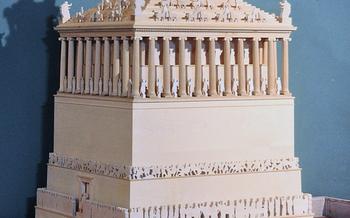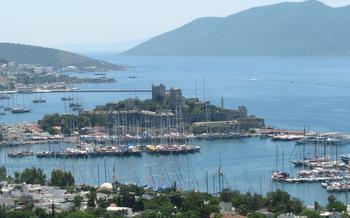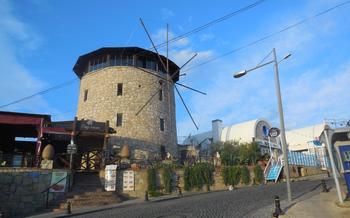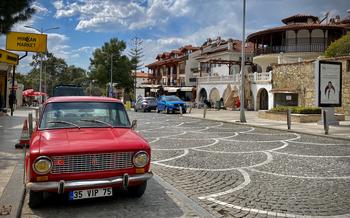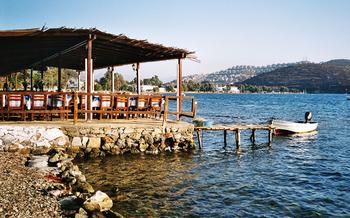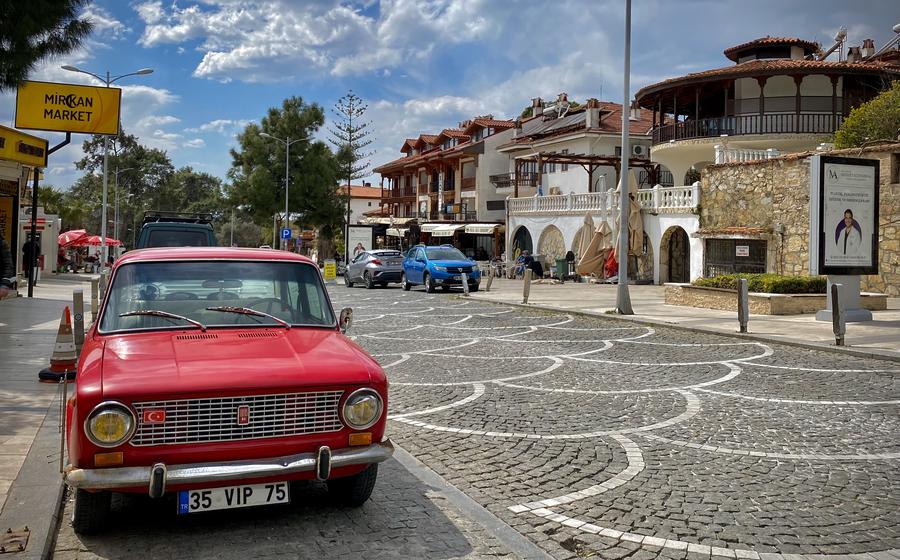
Bodrum Mausoleum
- Bodrum Mausoleum: A Majestic Symbol of Ancient History
- Historical significance
- Architectural marvels
- Location and accessibility
- Must-see attraction
- Unveiling the Mausoleum's History: A Journey Through Time
- Exploring the Architectural Masterpiece: A Fusion of Styles
- The Mausoleum's Fate: From Wonder to Ruin
- Location and Accessibility: Finding the Mausoleum's Remains
- Tips for Visiting the Bodrum Mausoleum: Making the Most of Your Experience
- Interactive Displays and Exhibitions: Bringing History to Life
- Guided Tours: Unveiling the Secrets of the Mausoleum
- The Mausoleum's Legacy: A Timeless Wonder
- Nearby Attractions: Beyond the Mausoleum
- Shopping and Dining: Indulge in Local Delights
- Accommodation Options: Rest and Relaxation in Bodrum
- Planning Your Trip: Practical Considerations
Bodrum Mausoleum: A Majestic Symbol of Ancient History
Historical significance
The Bodrum Mausoleum, also known as the Mausoleum at Halicarnassus, stands as a testament to the grandeur and architectural prowess of the ancient world. Built in the 4th century BC as a tomb for Mausolus, the satrap of Caria, this magnificent structure was recognized as one of the Seven Wonders of the Ancient World. Its sheer size, intricate design, and fusion of architectural styles continue to captivate visitors centuries after its creation.
Architectural marvels
The Mausoleum's architectural marvel lies in its unique blend of Greek, Egyptian, and Persian elements. The colossal structure featured a rectangular base surrounded by 36 Ionic columns, supporting a stepped pyramid roof adorned with elaborate sculptures. Atop the pyramid stood a colossal statue of Mausolus driving a four-horse chariot, a testament to his power and influence. This harmonious fusion of architectural styles showcased the cultural diversity and artistic achievements of the ancient world.
Location and accessibility
Situated in the heart of Bodrum, Turkey, the Bodrum Mausoleum is easily accessible by public transportation or private vehicle. Its proximity to other historical sites, such as the Bodrum Castle and the Bodrum Museum of Underwater Archaeology, makes it a popular destination for history and culture enthusiasts. Guided tours are available for a deeper understanding of the Mausoleum's history and architectural significance.
Must-see attraction
The Bodrum Mausoleum ranks among Turkey's must-see attractions, drawing visitors from around the world. Its historical significance, architectural grandeur, and unique fusion of styles make it a captivating destination for anyone interested in ancient history, architecture, or cultural heritage. A visit to the Bodrum Mausoleum offers a glimpse into the splendor and ingenuity of ancient civilizations, leaving a lasting impression on every traveler.
Unveiling the Mausoleum's History: A Journey Through Time
The Mausoleum of Halicarnassus was commissioned by Mausolus, the satrap or governor of Caria, a region in southwestern Turkey, as a grandiose tomb for himself and his wife, Artemisia II. Mausolus ruled Caria from 377 to 353 BCE and was known for his ambition and his patronage of the arts. His dream was to create a magnificent mausoleum that would rival the pyramids of Egypt and leave a lasting legacy for his kingdom.
Upon Mausolus's death in 353 BCE, Artemisia spared no expense in fulfilling her husband's wish. She commissioned the most skilled Greek architects and sculptors, including Pytheos, Satyros, and Bryaxis, to design and build the Mausoleum. The construction took several years, and Artemisia herself oversaw every detail until her own death in 350 BCE.
The Mausoleum was completed by Mausolus's successors and quickly gained recognition as one of the most impressive structures in the ancient world. Its grand design and intricate details earned it a place among the Seven Wonders of the Ancient World, alongside the Great Pyramid of Giza and the Hanging Gardens of Babylon.
Exploring the Architectural Masterpiece: A Fusion of Styles
The Mausoleum at Halicarnassus, a fusion of architectural wonders, brought together the artistry and expertise of Greek, Egyptian, and Persian architects and craftsmen. The result was a dazzling display of grandeur and innovation. The exterior was adorned with intricate sculptures and reliefs depicting mythological scenes, while the interior was embellished with opulent decorations and vibrant colors. The colossal statue of Mausolus, crafted from pure white marble, stood atop the tomb, symbolizing his power and authority. This architectural masterpiece set a new standard for funerary monuments and influenced future architectural endeavors throughout the Mediterranean region and beyond. Its intricate details and harmonious fusion of styles continue to captivate visitors, making it a true testament to the creativity and skill of the ancient world's master builders.
The Mausoleum's Fate: From Wonder to Ruin
The passage of time and the forces of nature conspired to bring about the downfall of the once-magnificent Bodrum Mausoleum. A devastating earthquake in 1494 dealt the structure a crippling blow, causing significant damage and initiating its gradual decline. Over the centuries, neglect and exposure to the elements further eroded its grandeur. As the centuries passed, the Mausoleum's treasures were plundered, and its materials were repurposed for other construction projects, diminishing its stature and grandeur. Today, the Mausoleum stands as an archaeological site, a testament to the power of time and the fragility of human creations.
Location and Accessibility: Finding the Mausoleum's Remains
Situated in the heart of Bodrum, Turkey, the remains of the Bodrum Mausoleum can be easily found. This ancient wonder lies within the confines of the Bodrum Castle, a medieval fortress that has become a prominent landmark in the city. Visitors can effortlessly reach the Mausoleum by utilizing public transportation or opting for the convenience of a private vehicle. Additionally, guided tours are readily available, providing an in-depth understanding of the Mausoleum's history and significance. Whether exploring independently or joining an organized tour, discovering the Bodrum Mausoleum is a captivating experience that delves into the depths of ancient history and architectural brilliance.
Tips for Visiting the Bodrum Mausoleum: Making the Most of Your Experience
Plan Your Visit for Optimal Conditions: Aim for the spring or fall seasons for pleasant weather, avoiding the scorching summer heat or chilly winter months.
Dress Comfortably: Wear comfortable shoes suitable for walking on uneven terrain. The site involves some climbing, so appropriate footwear is essential.
Capture the Mausoleum's Grandeur: Photography is permitted at the site. Bring your camera or smartphone to capture the Mausoleum's grandeur from various angles.
Respect the Site's Significance: Remember that the Mausoleum is a historical site of immense importance. Be respectful of the ruins and refrain from touching or climbing on them.
Stay Hydrated: Bring water or purchase it from nearby vendors. Hydration is crucial, especially during the hot summer months.
Interactive Displays and Exhibitions: Bringing History to Life
The Bodrum Mausoleum isn't just a pile of ruins; it's a gateway to the past, brought to life through interactive displays and exhibitions. Multimedia presentations showcase the Mausoleum's grandeur in all its glory, transporting visitors back in time. Artifacts and replicas provide a tangible connection to ancient craftsmanship, allowing visitors to appreciate the intricate details and artistry that went into its construction. Interactive exhibits engage visitors with the site's history, inviting them to explore the lives of Mausolus and Artemisia, the political and cultural significance of the Mausoleum, and its enduring legacy as one of the Seven Wonders of the Ancient World. Educational programs cater to students and history enthusiasts, offering a deeper dive into the Mausoleum's significance and its role in shaping ancient civilization.
Guided Tours: Unveiling the Secrets of the Mausoleum
To fully appreciate the historical significance and architectural marvels of the Bodrum Mausoleum, consider embarking on a guided tour. Professional guides, armed with in-depth knowledge and insights, bring the site's history to life with captivating narratives. They will take you on a journey through time, explaining the Mausoleum's construction, its significance in the ancient world, and its enduring legacy.
Customized tours can be tailored to specific interests and preferences, whether you're an architecture enthusiast, a history buff, or simply seeking a deeper understanding of this ancient wonder. Group discounts and special arrangements can be made for larger groups or educational institutions.
Advance booking is highly recommended to secure a spot on a guided tour, especially during peak tourist season. These tours offer an immersive experience, allowing you to delve into the secrets of the Mausoleum and gain a profound appreciation for its grandeur and historical importance.
The Mausoleum's Legacy: A Timeless Wonder
The Bodrum Mausoleum stands as a testament to the enduring legacy of ancient civilizations. Its recognition as a UNESCO World Heritage Site solidifies its status as a cultural treasure of global significance. The Mausoleum's architectural innovations and artistic achievements have served as inspiration for countless future architectural endeavors, demonstrating its lasting influence on the world of design.
Beyond its architectural significance, the Mausoleum represents a symbol of cultural exchange and artistic collaboration during the ancient world. The fusion of Greek, Egyptian, and Persian architectural elements reflects the cosmopolitan nature of the ancient city of Halicarnassus and its role as a crossroads of cultures. The Mausoleum's enduring legacy serves as a reminder of the power of cultural exchange in fostering innovation and creativity.
As we marvel at the ruins of this ancient wonder, we are reminded of the enduring human spirit and the pursuit of excellence that characterized ancient civilizations. The Bodrum Mausoleum stands as a symbol of the human capacity for artistic achievement and the enduring power of cultural heritage.
Nearby Attractions: Beyond the Mausoleum
While the Bodrum Mausoleum stands as the star attraction, the surrounding area offers a treasure trove of additional historical and natural wonders.
Bodrum Castle, a majestic medieval fortress, proudly stands on a peninsula overlooking the Aegean Sea. Immerse yourself in its captivating history as you explore its ramparts, towers, and dungeons. Ascend to the castle's highest point and be rewarded with panoramic vistas of the city, the Mausoleum, and the sparkling turquoise waters.
The Bodrum Museum of Underwater Archaeology houses an awe-inspiring collection of ancient artifacts recovered from shipwrecks along the Turkish coast. Discover intricately crafted amphorae, bronze sculptures, and jewelry that provide a glimpse into the maritime trade and cultural exchanges of bygone eras.
Venture beyond Bodrum to uncover even more historical gems. The awe-inspiring ancient theaters of Ephesus and Priene, with their remarkably preserved seating tiers and stage areas, offer a glimpse into the grandeur of ancient Greek performances.
Indulge in the beauty of the Turkish coastline by embarking on a boat tour. Explore hidden coves, pristine beaches, and secluded islands, marveling at the stunning rock formations and crystal-clear waters. Immerse yourself in the tranquility of the Aegean Sea as you soak up the Mediterranean sun and create lasting memories.
Shopping and Dining: Indulge in Local Delights
Bodrum, with its rich history and vibrant culture, offers a culinary and shopping experience that blends traditional Turkish delights with modern influences. Savor authentic Turkish cuisine at local restaurants, where the aroma of freshly grilled kebabs and the flavors of traditional mezes will tantalize your taste buds. Explore the vibrant markets for fresh produce, spices, and regional delicacies, where you can haggle for unique handicrafts and souvenirs. Indulge in Turkish coffee or tea while enjoying the ambiance of local cafes, watching the world go by. Bodrum's shopping and dining scene is an integral part of the city's charm, allowing visitors to immerse themselves in the local culture and create lasting memories.
Accommodation Options: Rest and Relaxation in Bodrum
Bodrum offers a diverse range of accommodation options, catering to travelers with varying budgets and preferences. From luxurious hotels with stunning views of the Aegean Sea to cozy guesthouses nestled in the heart of the town, there's something for everyone.
For those seeking a lavish stay, waterfront accommodations offer breathtaking panoramas of the turquoise waters and the iconic Bodrum Castle. These hotels provide world-class amenities, including private balconies, infinity pools, and gourmet restaurants, ensuring an unforgettable stay.
Budget-conscious travelers can opt for guesthouses and hostels, which offer a more intimate and authentic experience. These charming accommodations often feature traditional Turkish décor and provide a glimpse into the local culture.
Regardless of your budget, proximity to the Mausoleum and other attractions is a key consideration when choosing accommodation. Many hotels and guesthouses are situated within walking distance of the Mausoleum, allowing visitors to easily explore the site and other historical landmarks.
To avoid disappointment, advance reservations are highly recommended, especially during the peak tourist season, which runs from June to September. Online booking platforms and travel agents can assist in finding the ideal accommodation that matches your needs and preferences.
Planning Your Trip: Practical Considerations
Before embarking on your journey to the Bodrum Mausoleum, it's essential to consider a few practical aspects to ensure a smooth and enjoyable trip.
Visa Requirements and Travel Documents:
Check visa requirements for your nationality. Some countries may require a visa to enter Turkey. Obtain the necessary travel documents, including a valid passport with sufficient validity.
Currency Exchange and Payment Options:
The official currency of Turkey is the Turkish Lira (TRY). Exchange your currency at reputable exchange bureaus or banks before your trip. Credit cards are widely accepted, but it's recommended to have some cash on hand for smaller purchases.
Local Customs and Etiquette:
Respect local customs and traditions. Dress modestly, especially when visiting religious sites. Learn a few basic Turkish phrases to communicate with locals.
Health and Safety Precautions:
Turkey is generally a safe country for travelers. However, it's advisable to take precautions such as avoiding isolated areas at night, being aware of your surroundings, and keeping your valuables secure. Pack any necessary medications and consult a doctor if you have specific health concerns.
By considering these practical aspects, you can ensure a hassle-free and enriching experience as you explore the wonders of the Bodrum Mausoleum and the surrounding region.
